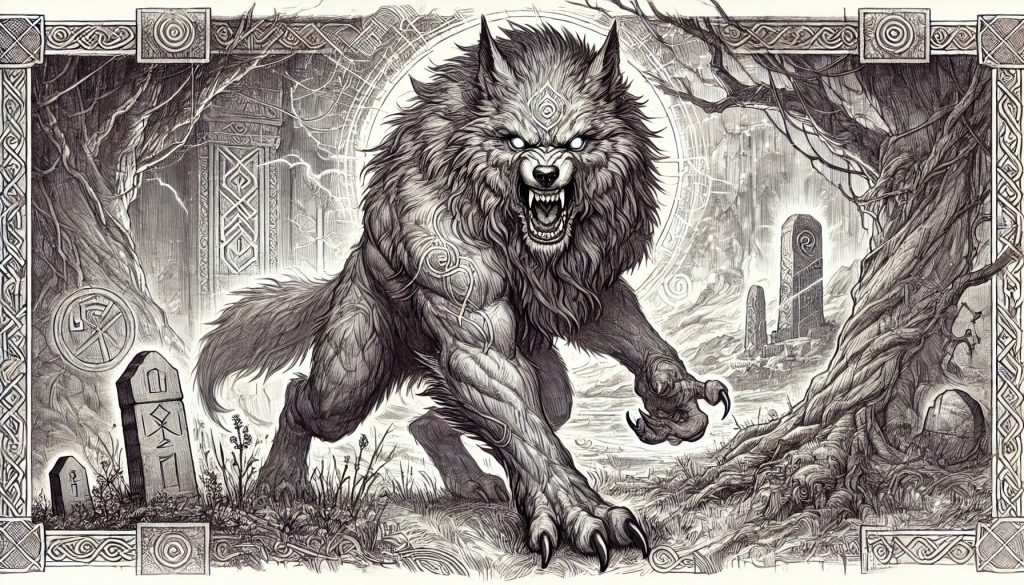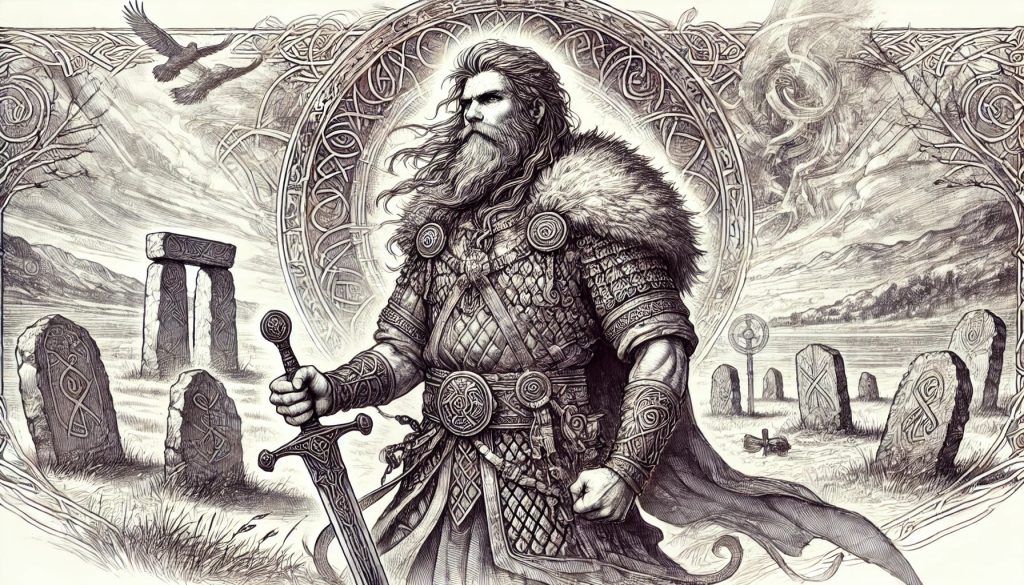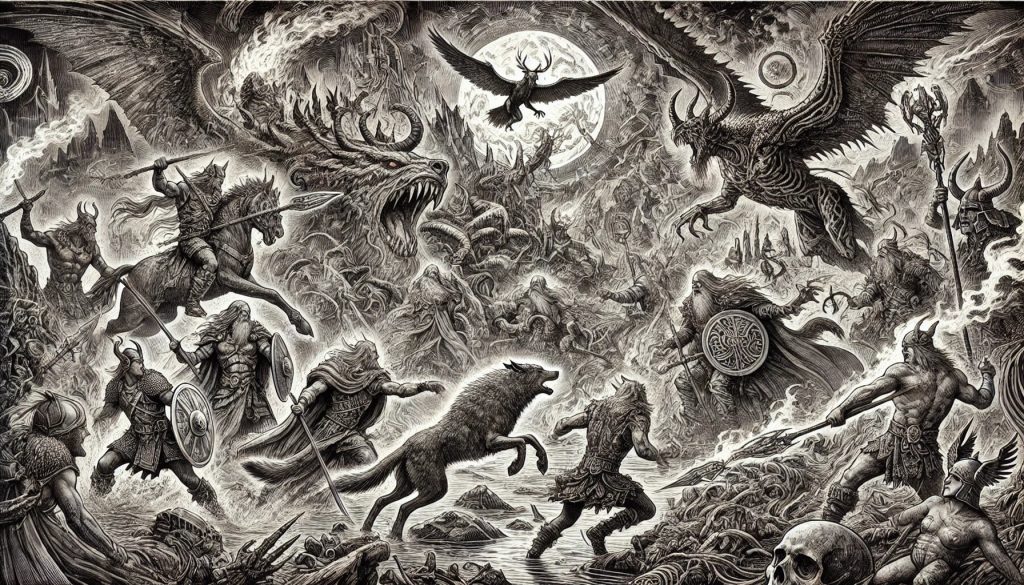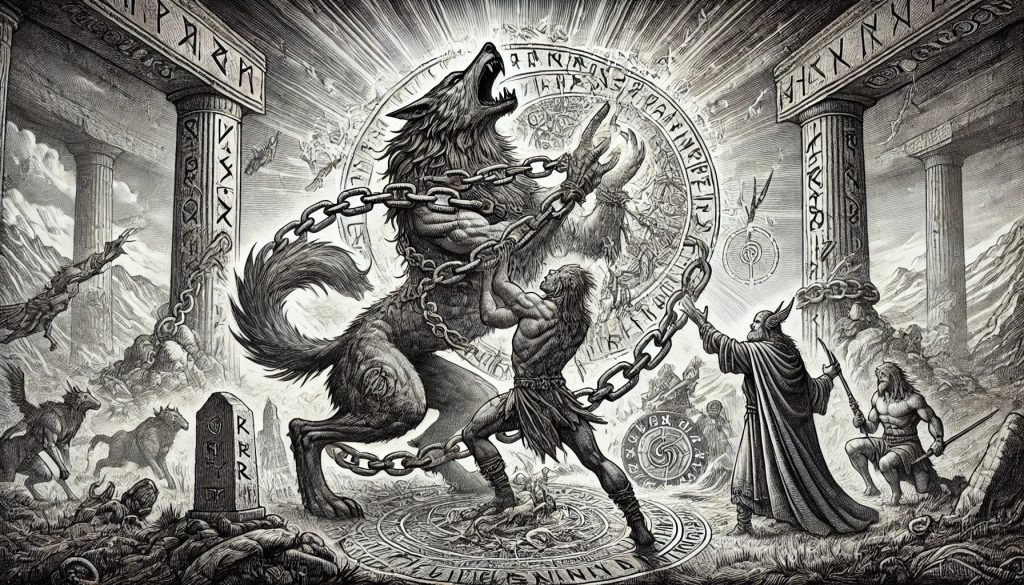Creatures in Norse mythology, Fenrir, Loki, Norse Mythology, Odin, Ragnarok, Tales of the Gods, Tyr
The Binding Of Fenrir
The Binding of Fenrir is a tale from Norse mythology that has stood the test of time. It tells the story of the mighty wolf Fenrir and his part in the end of the world, Ragnarok. The gods tried to stop him, making great sacrifices to prevent his destruction. Let’s dive into the story of how they bound Fenrir and its deep meaning in Norse tales.
Overview of Norse Mythology
Norse mythology is a treasure trove of legends from ancient Scandinavia. It tells of mighty gods, exciting quests, and the universe’s secrets. Knowing about Norse mythology helps us grasp Fenrir’s significance in these epic tales.
These stories come from the Germanic tribes of old. They are filled with gods and goddesses, each with their own powers. The myths also talk about the end of the world, known as Ragnarök, and the giants and monsters that roam the nine worlds.
At the heart of Norse mythology is the story of the gods and their battles against evil forces. Heroes and villains clash, and the fate of the universe hangs in the balance. The gods and goddesses, like Odin, Thor, and Freyja, are central to these tales.
These stories have been passed down through generations, captivating people with their vivid imagery and deep meanings. They offer insights into the beliefs and values of the ancient Scandinavians. Norse mythology is a window into a world that is both magical and brutal.
Now, let’s dive deeper into the story of Fenrir, a powerful giant serpent in Norse mythology. His binding is a key part of the myths, showing the gods’ efforts to control the forces of chaos in Asgard.
Introduction to Fenrir: The Fearsome Wolf
Fenrir, also known as Fenrisúlfr, is a monstrous wolf in Norse mythology. He is the child of Loki, a mischievous god, and Angrboda, a giantess. Fenrir is known for his strength and fear he inspires in gods and humans.
At birth, Fenrir showed incredible strength and an endless hunger. He is huge, with massive jaws and sharp teeth. Legends say he has fur as dark as night, making him look powerful and cruel.
The gods saw Fenrir as a huge threat. They knew he could start Ragnarok, the end of the world. So, they planned to bind him to stop his destructive power.
Exploring Fenrir’s legend, we’ll see the gods’ efforts to control him. We’ll learn about the sacrifices they made to keep the realms safe. This story is about the battle between evil and the gods, showing Fenrir’s power in Norse mythology.
Let’s dive into the world of Fenrir, the monstrous wolf who was said to devour all. Discover how his story is key to understanding the gods’ world.
The Growing Threat: Fenrir’s Rise
As Fenrir grew in size and power, the gods feared the chaos and destruction he would cause. They knew from prophecies that Fenrir would play a big part in Ragnarok, the end of the world.

The gods wanted to stop Fenrir from causing harm. They planned to make a fetter called Gleipnir to hold him back. This would stop his power from causing trouble.
We will examine the gods’ worries and efforts to change Fenrir’s fate. They used careful planning and divine tricks to bind Fenrir to protect the realms from his anger.
Prophecies of Destruction and Ragnarok
The prophecies tell of Ragnarok, the Norse apocalypse. These ancient predictions speak of the world’s doom. They have been passed down for generations.
They warn of a huge battle between gods and giants. This battle will bring chaos and fire to all creation. The fate of the gods and the universe depends on this battle’s outcome.
Fenrir, the giant wolf, is set to play a big part in these prophecies. His rise and binding are key signs of Ragnarok.
These prophecies elicit a mix of excitement and fear. They highlight the urgency and importance of the gods’ fight against the wolf, which aims to stop the destruction of their world.
The prophecies of Ragnarok show how fragile our existence is. They remind us of the constant threat of chaos, even for the gods. Through these prophecies, Fenrir’s story becomes a legendary tale with lasting importance in Norse mythology stories.
The Gods’ Plan to Control Fenrir
The gods came up with a detailed plan to control Fenrir as he grew stronger and more capable of bringing ruin to Asgard. They knew that if Fenrir was not stopped, he could destroy everything. So, they worked hard to stop him before it was too late.
At the heart of their plan was Gleipnir, a special chain made strong enough to hold Fenrir despite his incredible strength. The gods believed Gleipnir could stop Fenrir from causing harm.
But just tying Fenrir up wasn’t enough. The gods also planned to trick him into letting them bind him. Loki, the god known for his clever tricks, was key to this part of the plan.
Loki used his cleverness to convince Fenrir to let the gods bind him with Gleipnir. He made Fenrir think hiding the gods’ true motives was a good idea.
To make the plan work, a sacrifice was needed. Tyr, the god of war, offered his hand as a sign of trust. All the gods were there, and Tyr put his hand into Fenrir’s mouth, showing his bravery.
When Fenrir found out he was tricked, he bit off Tyr’s hand. This act showed how serious the gods were about stopping Fenrir. It also made sure Fenrir was tied up with Gleipnir.
Thanks to Gleipnir and Tyr’s sacrifice, the gods were able to control Fenrir. The wolf was now safe and couldn’t harm anyone. This saved the realms from a big disaster, thanks to the gods’ cleverness and bravery in Asgard.
Forging Gleipnir: The Magical Chain
The making of Gleipnir was a remarkable event. It needed the skills of skilled dwarves, known for their unmatched craftsmanship. This part looks into how Gleipnir, the magical chain, was made. It would later bind the fierce wolf, Fenrir.
The Exceptional Craftsmanship
The dwarves used their unmatched skills to make Gleipnir. This magical chain was unlike anything before. It was made with great precision and detail, showing the dwarves’ skill.
A Fetter of Unmatched Strength
Gleipnir was made from rare and strong materials. It was incredibly strong, strong enough to hold back Fenrir. The magic in the chain made it impossible to break, surprising even the strongest foes in Asgard.
A Chain Both Smooth and Soft
Even though Gleipnir was very strong, it was also surprisingly smooth and soft. This made it even more mysterious and fascinating.
The Enchantment of Gleipnir
Gleipnir was more than just a strong chain. It was enchanted to trick and trap Fenrir, keeping him captive forever. The magic in Gleipnir made it powerful and resilient, symbolizing Fenrir’s defeat.
The Deception: Tricking Fenrir
The gods wanted to bind Fenrir, a powerful wolf from Norse mythology. They came up with a smart plan to trick him and gain his trust. They knew Fenrir was strong and smart, so they needed a clever strategy to outsmart him.
They showed him Gleipnir, a magical chain that seemed unbreakable. They asked Fenrir to try to break free, thinking it would show his strength. Fenrir, not knowing Gleipnir’s true nature, was eager to prove his power.
This was Fenrir’s biggest test. The gods tricked him into thinking the chain was just another challenge. But Gleipnir was made to be impossible to break, designed to keep Fenrir trapped forever.
The gods used Fenrir’s trust to their advantage. They played on his desire to prove himself. They made him think the challenge was real, making him fully commit. Fenrir’s determination to win led him right into the trap.
Fenrir’s story shows how clever the gods were. They used his trust and made a challenge he couldn’t beat. This put them in control, making sure they could bind Fenrir and protect the realms from his harm.
The Sacrifice of Tyr
The gods had a big task ahead of them. They needed to convince Fenrir, the mighty wolf, that they meant no harm. Fenrir, knowing the gods were scared, asked for a sign of their good intentions. Týr, the brave god of war and justice, stepped up with courage.

Tyr showed his deep commitment by offering his hand. He knew Fenrir would bite it off during the binding. But he did it for the greater good of the Norse realms.
When Fenrir bit off Tyr’s hand, it showed the gods’ strong will. Tyr’s act proved his trust in the gods and their plan. He believed they could stop Fenrir and save the world from destruction.
Tyr’s sacrifice showed the gods’ determination and faith. It reminded everyone of the sacrifices needed for peace and justice. His act was a powerful message of courage and selflessness.
The sacrifice of Tyr is a symbol of bravery and the price of peace. It shows the gods’ deep devotion to protecting their world from Fenrir’s destruction.
The Successful Binding
With a sacrifice and a clever trick, the gods tied up Fenrir, a key moment in stopping Ragnarok. They used the magical chain Gleipnir to hold back the wolf and stop his harm.
The gods’ cleverness paid off as they tricked Fenrir into testing the magical chain’s strength. Fenrir, not knowing Gleipnir’s true power, agreed to the test.
As Fenrir opened his huge mouth, the gods quickly used the magical chain made from unlikely things:
- The sound of a cat’s footsteps
- The beard of a woman
- The roots of a mountain
- The sinew of a bear
- The breath of a fish
- Gleipnir, looking weak, actually got stronger as Fenrir pulled on it. The gods won not by strength but by cleverness and magic.
- Fenrir tried hard to break free but couldn’t. His anger was huge, but he was stuck.
- Now trapped, Fenrir showed how smart the gods were. They had stopped the monster, keeping the Nine Realms safe.
The gods were overjoyed with their win in Asgard. They had kept the chaos monster away, keeping peace and happiness in the realms. This big step brought them closer to stopping Ragnarok and keeping the good times going.
Fenrir’s Imprisonment and Its Significance
Fenrir’s imprisonment was crucial for the gods and the realms they protected. It showed how far the gods would go to keep the realms safe from Fenrir’s destruction.
In Norse myths, locking up Fenrir was key to stopping Ragnarok, a disaster. The gods used Gleipnir, a magical chain, to hold him back, stopping him from causing harm immediately.
This action showed the gods’ smart planning and bravery. They knew Fenrir was a huge threat because of his strength and hunger. But they were ready to stop him to protect their worlds.
The gods gave themselves a break by keeping Fenrir trapped and delaying Ragnarok. This stopped Fenrir from causing chaos, giving the gods time to prepare for the big event.
Fenrir’s capture was a big deal. It proved the gods could keep things in order, even when faced with huge dangers. The realms stayed safe, and balance was kept between chaos and peace.
But Fenrir’s story wasn’t over yet. Even though he was locked up, he was still a threat. His part in Ragnarok would change the course of the world, making everyone wait with bated breath for the end.
In the end, Fenrir’s imprisonment was a key event in Norse myths. It showed the gods’ resolve to save their realms and delay Ragnarok. The story of Fenrir teaches us about the power of planning, sacrifice, and balance in the face of danger.
Foreshadowing Ragnarok: Fenrir’s Role in the End Times
Fenrir’s binding offered a brief reprieve, but it was just a hint of the big events to come in Ragnarok, as foretold in Norse mythology stories. This part looks at how Fenrir will play a big part in the final battle that ends the world.

Fenrir’s meeting with Skírnir, a giantess, is a key moment in Ragnarok. Being Loki and Angrboða’s son, Fenrir links to giants, setting the stage for the world’s end. Skírnir, who guards Gerðr, is vital to Fenrir’s story, leading up to the big fight.
Before Ragnarok, Fenrir wants to eat the sun, showing his challenge to the current order and his aim to end the world. The sun stands for life, warmth, and light. Fenrir’s move fills us with a sense of doom, making us feel the end is near.
In the battle, Fenrir’s strength and will show his key role in ending the world. He fights Odin, playing a big part in the world’s destruction and the start of a new one.
Fenrir’s part in Ragnarok shows us the world’s end is sure to come. His power will not be stopped despite the gods’ efforts to hold him back. The fight against him marks a big change, ending one world and starting another.
Mythological Themes and Interpretations
The story of Fenrir’s binding is full of mythological themes. It shows the cosmic battle between gods and giants. It’s a tale of deep symbolism and offers many interpretations. These shed light on themes like betrayal and sacrifice.
The core of the story is about power and control. The gods wanted to stop Fenrir from growing too powerful. This struggle between order and chaos is a common theme in myths. It shows the endless fight between different forces.
Betrayal is a big theme here, too. Fenrir trusted the gods, but they tricked him. The gods sacrificed their allies to keep order and protect their world.
Looking deeper, the story of Fenrir’s binding can be seen as a metaphor for life and death. The binding of chaos shows a temporary stop to chaos. But, it hints at chaos’s return and the end of the world, Ragnarok.
The sacrifice of Tyr, known for his bravery, adds more depth to the story. Tyr gave his hand to Fenrir as a promise. This act shows the struggle between doing what’s right and personal loss. It highlights the heavy responsibility and sacrifices needed to keep the world in balance.
These themes and interpretations give us a deeper look at Fenrir’s story. Through Norse mythology, the tale explores big ideas like power, betrayal, sacrifice, and the cycle of life. It offers deep insights into what it means to be human.
Cultural Impact of Fenrir’s Story
Fenrir’s story has deeply moved many people and left a big mark on culture. It’s seen in media like books, movies, games, and art, often retelling old Norse mythology stories. This tale and all of Norse mythology inspire many creators and fascinate fans and the public.
Many authors have used Norse mythology, including Fenrir’s tale, in their stories, making Fenrir’s story a key part of storytelling in many genres, from fantasy to historical fiction.
Films have also been influenced by Fenrir’s story. Movies bring the tale of Fenrir’s rise and binding to life. They make Norse mythology known to more people through beautiful visuals and engaging stories.
Fenrir’s story is a huge part of video games. Game makers use Fenrir and Norse myths to create exciting games. Players experience Norse mythology, face Fenrir, and witness epic battles that decide the gods’ fate.
Artists love Fenrir’s story for its deep meaning. They use it in their work, making paintings and sculptures. These pieces show how Norse mythology still affects art today, keeping its themes of power and struggle alive.
Fenrir’s story shows how much Norse mythology means to us. It keeps drawing in new fans and creators, keeping its place in pop culture. For those who love myths, Fenrir’s story is a powerful example of how stories can touch us across time and cultures.
Conclusion
The story of Fenrir’s binding is a captivating tale in Norse mythology. It shows how prophecies, deception, sacrifice, and cosmic battles are linked. This binding is a temporary fix to delay Ragnarok and protect the Nine Realms. Yet, the threat of the apocalypse still looms, showing the delicate balance between order and chaos.
Thinking about Fenrir’s binding makes us realize how myths shape our view of the world and its secrets. Fenrir’s part in Ragnarok adds depth to the story, making us feel both excited and worried. It shows the gods’ detailed plans and sacrifices to keep the universe in balance.
The gods outsmart and control Fenrir, but only for a while. Ragnarok’s certainty shows their victory is short-lived. Fenrir’s story teaches us about the cycle of life and death, where creation and destruction are linked.
Fenrir’s binding highlights the ongoing battle between fate, free will, and the gods’ fragile power. This myth offers deep insights into human nature beyond Norse tales. It shows the lasting impact of stories that capture our imagination over time.

